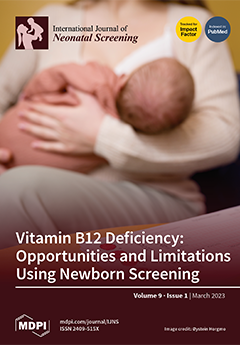Open AccessArticle
Newborn Screening Long-Term Follow-Up Clinics (Continuity Clinics) in the Philippines during the COVID-19 Pandemic: Continuing Quality Patient Care
by
Ebner Bon G. Maceda, Michelle E. Abadingo, Karen Asuncion R. Panol, Frederick David E. Beltran, Ivy Rose C. Valdez-Acosta, Grandelee D. Taquiqui, Sharon B. Gawigawen, Maria Victoria L. Macalino, Laura Maria Soledad M. Aguirre-Aguinaldo, Marive A. Flores-Declaro, Karen June V. Ventilacion, Ma. Rita Anna Salve R. Boligao, Nancy G. Honor, Mirasol S. Ellong, Rona D. Ocho-Ortencio, Genelynne J. Beley, Maria Christina N. Bondoc-Eran, Bradford L. Therrell, Jr. and Carmencita D. Padilla
Cited by 2 | Viewed by 3420
Abstract
The COVID-19 pandemic has challenged healthcare systems worldwide. In the Philippines, long-term care for patients with conditions identified through newborn screening (NBS) is coordinated through Newborn Screening Continuity Clinics (NBSCCs). These clinics are integral to achieving optimal outcomes by providing follow-up oversight and
[...] Read more.
The COVID-19 pandemic has challenged healthcare systems worldwide. In the Philippines, long-term care for patients with conditions identified through newborn screening (NBS) is coordinated through Newborn Screening Continuity Clinics (NBSCCs). These clinics are integral to achieving optimal outcomes by providing follow-up oversight and assistance for individuals identified through screening. Continuity of NBSCC care for NBS during the COVID-19 pandemic was both challenging and necessary and was accomplished through innovative strategies of dedicated personnel. Following the discontinuation of the community quarantine, a situation assessment survey was completed by each NBSCC to better understand the challenges encountered and their effect on patient care. Performance data from each NBSCC were reviewed both before and after an extended community quarantine (2018–2021) to evaluate the impact of NBSCC disaster contingency plans in overcoming the resultant challenges (transportation, supply chain, etc.). Thematic analysis of the survey showed three primary challenges: Operations, communications, and safety. In 2018 and 2019, successful patient contacts were 70.6% and 70.2%, respectively. During the pandemic, successful contacts were 74.9% in 2020 and 76.8% in 2021, demonstrating that the contact approaches taken by the NBSCCs were sufficient to maintain (and even improve) patient contacts. The number of unresponsive patients decreased during the pandemic likely due to decreased mobility and improved follow-up actions from the NBSCCs.
Full article
►▼
Show Figures






